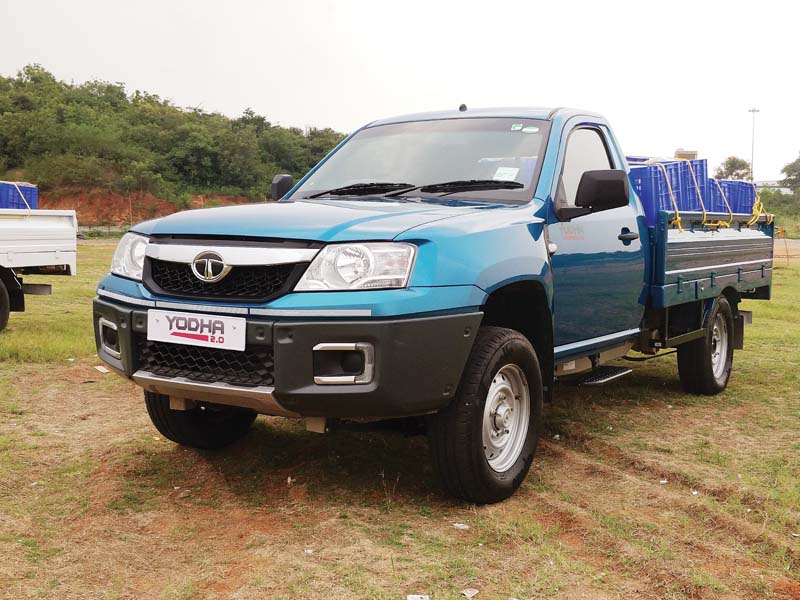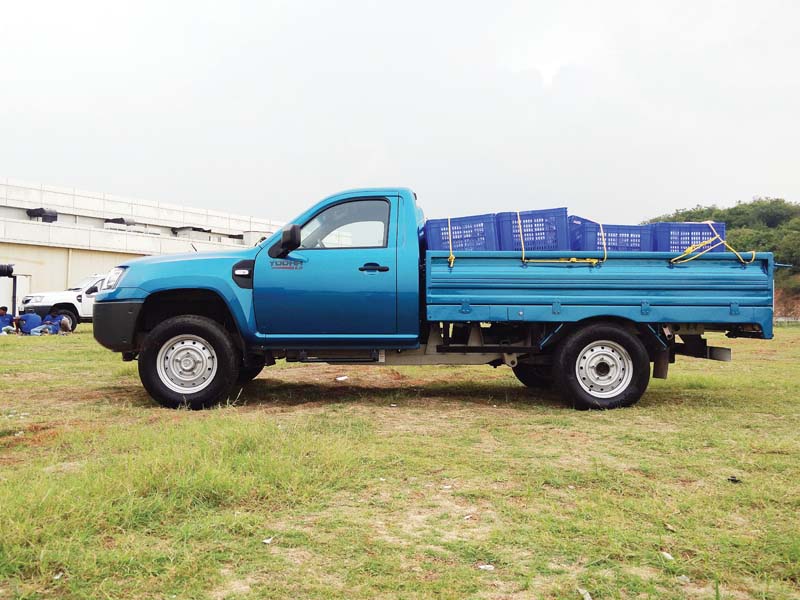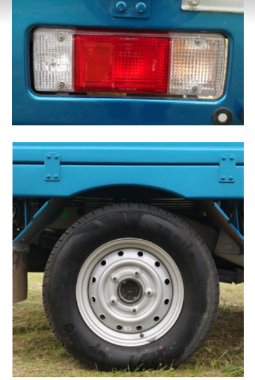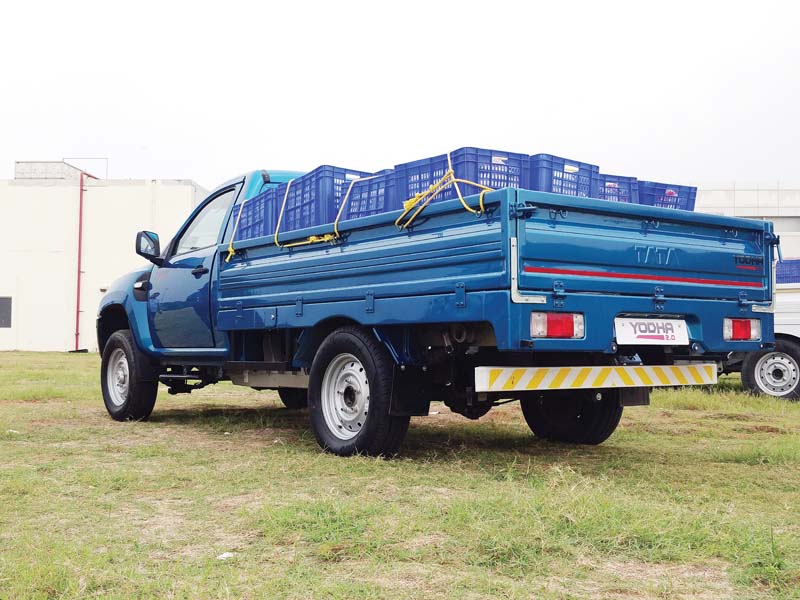As part of its pick-up revamp strategy, Tata Motors brings in the Yodha 2.0. Prateek Pardeshi test drives it on a specially built track in Hyderabad.
 Original Equipment Manufacturers had to put their plan on the back burners thanks to the lethal pandemic Covid-19. This included putting brakes on the rollout of new product variants. Here Tata Motors must be credited for sustaining the tag of a full-range player! The company was due for the commercialisation of its pickup range, which the company gave glimpses of nearly three-years at the Auto Expo 2020, in Noida. Some of those plans could not take off. Fast forward to 2022, the company revisited the Tata Yodha project and rolled out the Yodha 2.0 at a glittery affair in Hyderabad. The Yodha 2.0 face lift goes beyond just cosmetic changes. It encompasses a single and crew cab variant in different configurations priced upwards of Rs.9.16 Lakhs with the top variant priced at Rs.9.99 lakhs (Ex-showroom). The Yodha is now more muscular then ever before.
Original Equipment Manufacturers had to put their plan on the back burners thanks to the lethal pandemic Covid-19. This included putting brakes on the rollout of new product variants. Here Tata Motors must be credited for sustaining the tag of a full-range player! The company was due for the commercialisation of its pickup range, which the company gave glimpses of nearly three-years at the Auto Expo 2020, in Noida. Some of those plans could not take off. Fast forward to 2022, the company revisited the Tata Yodha project and rolled out the Yodha 2.0 at a glittery affair in Hyderabad. The Yodha 2.0 face lift goes beyond just cosmetic changes. It encompasses a single and crew cab variant in different configurations priced upwards of Rs.9.16 Lakhs with the top variant priced at Rs.9.99 lakhs (Ex-showroom). The Yodha is now more muscular then ever before.
 In all, the company showcased six variants with five 4×2 variants and one 4×4 variant. The latter has in the past won accolades from critiques. The 4×2 variants showcased included the Yodha 2.0 1700, 1500, 1200, and Yodha Ex (Dual cab). The 4×4 standard variant accompanied this lineup on display. On a Year-To-Date (YTD) basis, the pickup segment has sold 15,618 units for the company with an eight per cent decrease. With the new rollouts, the company hopes to build on its market share and perform better in the coming months. Averred Girish Wagh, Executive Director, Tata Motors, “The introduction of these new-age pickups reiterates our commitment to always empower and equip the customers with best-in-class vehicles to deliver more progress and success.” Yodha 2.0 has the best-in-class, rated payload capacity of two-tonne and is among the leading pick-up truck options out there.
In all, the company showcased six variants with five 4×2 variants and one 4×4 variant. The latter has in the past won accolades from critiques. The 4×2 variants showcased included the Yodha 2.0 1700, 1500, 1200, and Yodha Ex (Dual cab). The 4×4 standard variant accompanied this lineup on display. On a Year-To-Date (YTD) basis, the pickup segment has sold 15,618 units for the company with an eight per cent decrease. With the new rollouts, the company hopes to build on its market share and perform better in the coming months. Averred Girish Wagh, Executive Director, Tata Motors, “The introduction of these new-age pickups reiterates our commitment to always empower and equip the customers with best-in-class vehicles to deliver more progress and success.” Yodha 2.0 has the best-in-class, rated payload capacity of two-tonne and is among the leading pick-up truck options out there.
The design
The refreshed design language has the front fascia display noticeable changes on the Yodha 2.0 4×2 model, we drove. This includes the chrome-heavy front grille, and the two-piece front bumper made up of a combination of metal and fibre to strike the ideal balance between stiffness and strength-to-weight ratio. The metal bumper is divided further into three pieces to lower the replacement cost against a single-piece bumper. It also lends to the contemporary yet rugged look. The skid plate with silver highlights adds a dash of premium to the tough quotient. There is a provision for fog lights with neatly integrated front reflectors akin to Daylight Running Lamps (DRL). Overall the headlight cluster doesn’t dare to deviate much from the older-generation Yodha (erstwhile Xenon). The overall aerodynamic shape is similar with lines running across the side.
From this angle, the side reveals a re-designed fender home to the side indicators and replicated on either side of the pickup truck. One also notices the 3150 mm wheelbase and the biggest USP being the external load tray with a length of 2643 mm and width of 1843 mm. To the naked eye, the loading tray stays the same from here. The ground clearance of up to 210 mm for the 4×2 variants ensures the requisite suspension travel and boasts of an underbody guarded even on tough terrains like the track, we tested it on. The installation of a rigid metal footrest for easy ingress and egress is a well-thought-out inclusion for the pilot and the co-pilot. The fuel tank cover sports a retro design that relies on a manual lock. It could be replaced with cable-operated fuel lids in the age of keyless controls. If the design language is drawing parallels between pick-ups from competition, the left-hand side mount could add to operator inconvenience in our opinion.
The Yodha plys on rubber grips sourced from Apollo, Endu Maxx LT installed on 16-inch steel rims. These are deemed perfect for off-road and the long-haul. For safety and homologation purposes, the Yodha is equipped with a side crash guard. In total there are 13 rope hooks welded on the loading tray which ensures a firm grip over the luggage. The icing on the cake is the body color tone to make them rustproof.
On the rear end, the Yodha 2.0 bears a giant crash guard to prevent any chances of an undercarriage hit, up as a collision impact absorber. The tail lights flash on a conventional bulb setup. The most interesting feature here is the four reverse sensors, primarily two-stage beepers. They assist with parking in tight spaces. The loading tray flap rests on three hinges which are again body coloured and well-camouflaged. It has the convenient functionality of old-school sliding compared to competitors opting for modern, spring-operated latches.
Step inside
The door is rugged, no doubt! The cabin welcomes the operator with a three-spoke steering akin to passenger segment offerings from the Tata stable. It has an uncanny resemblance to the Tigor hatchbacks. I was able to manoeuvre it with a single hand much to my co-pilot’s surprise. We recommend using the conventional 10 and two grip though especially when plying in the laden state. The grip is comfortable and lends to the assurance needed for U-turns. The instrument cluster is spartan and relays the required information without any fuss. Two analogue dials have the left one hosting the speedometer and the right one home to the tachometer which redlines at 5000 rpm all the way up to 7000 rpm.
The LCD display unit relays important metrics like a fuel gauge, engine temperature, time, odometer and the gear engaged. The dashboard design is a fine balance of practical and ergonomy. The HVAC system is suited for tropical countries like India. On the right side of the steering, the operator can reach out to the headlight lens level adjuster, switch on the ‘Eco’ mode and access the DPF warning light without any fret. A 5V 2.4A USB charging socket meets charging duties for handhelds that the driver may carry. Tilt down, the gear shifter has silver inserts complementing the black leather wraparound. The vehicle offers enhanced storage on the co-pilot side with a vertical mobile holder slot and room for documents and log books. The glove box moves up and doubles up as a cup holder for that pit stop en route. The driver has to lean over to the co-pilot side to access the bottle holder which could be inconvenient for some. The hand brake positioning on the right-hand side perplexed us! Overall, the cabin with split seats lends to requisite ergonomics especially with the adjustable headrests that get a thumbs up.
Under the hood
On driving the Yodha, the power of the four-cylinder, 2.2-litre BSVI Direct Injection engine was found to not left wanting. At the core and common to all Yodha variants (irrespective of the load-baring capability), the engine produces an estimated 98.9 hp at 3750 rpm. It develops a peak-rated, flat torque of 250 Nm in the 1000-2500 rpm range. The overall gear lever travel is very similar to an SUV and offers shifts in a seamless manner. As far as the suspension travel goes, the vehicle has heavy-duty, rigid suspension with semi-elliptical leaf springs made up of six leaves at the front and an innovative two-stage semi-elliptical leaf spring setup with nine leaves at the rear.
Driveability
Driving the Yodha 2.0 with two-tonne payload at the back was easier than we anticipated it to be. This speaks of Tata’s engineering that allows the apt punch to help operators maintain a low Total Cost of Ownership (TCO). Some might argue, it is a trade-off with cosmetic inclusions that make a pick-up more desirable but the Target Group (TG) is different here. The track we drove on, was split into three sections, a chicane with an off road patch (A), rock bed and water wadding sections. This was followed by steep inclines and declines (B), and section (C) that greeted us with loose gravel and steeper inclines testing the grade ability of the vehicle. The Yodha tackled it with ease.
 The commanding stance of the driver ensures the hood is partially visible and the pickup is easy to manoeuvre. With the seat belts on, clutch depressed, neutral gear engaged and engine cranked, the excitement of a take-off fell flat. Wait a minute! The vehicle continues to beep. A quick hygiene check revealed the reason. It was the partially disengaged hand brake. Now what? When the hazard switch is on, the relay sound sets off. On reversing a bit before hitting the track, the reverse sensor beeps joined forces with the relay making it hard to differentiate one from the other. This is not the case with competition offering distinct sound alerts. Past this stage, the vehicle in a fully-laden state is easy to command on flats. The challenging bit of getting the vehicle to a complete halt on a steep climb before rolling again is where most drivers are challenged. Here, the climb resembling the ghats was made easy thanks to the power dynamics of the pick-up. It never ran out of juice despite the engine power being shaved off by ~10-15 per cent courtesy the air-conditioning. At section ‘A’ I had to steer through the chicane, where the steering rack and pinion were put to good test. The hydraulic steering felt light at high speeds, and the three-spoke design lent good grip all along.
The commanding stance of the driver ensures the hood is partially visible and the pickup is easy to manoeuvre. With the seat belts on, clutch depressed, neutral gear engaged and engine cranked, the excitement of a take-off fell flat. Wait a minute! The vehicle continues to beep. A quick hygiene check revealed the reason. It was the partially disengaged hand brake. Now what? When the hazard switch is on, the relay sound sets off. On reversing a bit before hitting the track, the reverse sensor beeps joined forces with the relay making it hard to differentiate one from the other. This is not the case with competition offering distinct sound alerts. Past this stage, the vehicle in a fully-laden state is easy to command on flats. The challenging bit of getting the vehicle to a complete halt on a steep climb before rolling again is where most drivers are challenged. Here, the climb resembling the ghats was made easy thanks to the power dynamics of the pick-up. It never ran out of juice despite the engine power being shaved off by ~10-15 per cent courtesy the air-conditioning. At section ‘A’ I had to steer through the chicane, where the steering rack and pinion were put to good test. The hydraulic steering felt light at high speeds, and the three-spoke design lent good grip all along.
 The section with the loose gravel patch required me to push the pedal to the metal and soon thereafter apply the brakes sharply. At first, in the Economy mode (ECO) with a 45 kmph speed. It forced out a tyre screech in a subdued performance. The lack of ABS was felt here. Yodha 2.0 relies on discs at the front with dual-acting pistons and drums on the rear. In the Power mode, at lower rpm, it’s easy to sense the marginal shift in the engine performance. The turbo kicked in at about 2500 rpm which helped to distinguish one mode from the other and the brakes didn’t disappoint given the short travel.
The section with the loose gravel patch required me to push the pedal to the metal and soon thereafter apply the brakes sharply. At first, in the Economy mode (ECO) with a 45 kmph speed. It forced out a tyre screech in a subdued performance. The lack of ABS was felt here. Yodha 2.0 relies on discs at the front with dual-acting pistons and drums on the rear. In the Power mode, at lower rpm, it’s easy to sense the marginal shift in the engine performance. The turbo kicked in at about 2500 rpm which helped to distinguish one mode from the other and the brakes didn’t disappoint given the short travel.
On the ‘B’ section, the suspensions were put to test. The suspension travel from the leaf springs was impressive with a smooth shock-free ride internally. For the descent and ascend in quick succession, the brakes did their duties with a gentle tap and release motion. On the water wade section, a sharp right post a wide turn gave a sense of the work done on reducing the body roll. Tata Motors has also paid special attention to lubrication with a lifetime assurance on the cardan shaft.
On to the climax! The C section drive was uphill for about 100 m. The loose gravel simulating the rural terrains of the country. A stretch here had us traverse a steep incline followed by a 90-degree turn which could have gone either way. Thanks to the race track experienced instructor, I got good advice in the nick of time. In the first gear and over 2500 rpm, we sailed past the hurdle with a combination of gradual throttle and a mix of brake taps. That I was able to go through the off-road experience without a stall, speaks volumes of the compounded impact of skill sets marrying the apt engineering.
Overall the vehicle feels easy to manoeuvre and sets the benchmark with its segments first. That the competition is catching up on some fronts and outdoing on other fronts, Tata Motors has its task cut out. Following the launch, it can set up a future iteration based on customer feedback. Up front, these could revolve around the driver’s ergonomics, utility features, and more optimal power-to-weight ratios for each of the sub-variants of the Yodha 2.0. The 20,000 km engine oil drain interval and three years/three lakh warranty (on the driveline) backed by a strong after sales network could win it patronage like in the past.




















